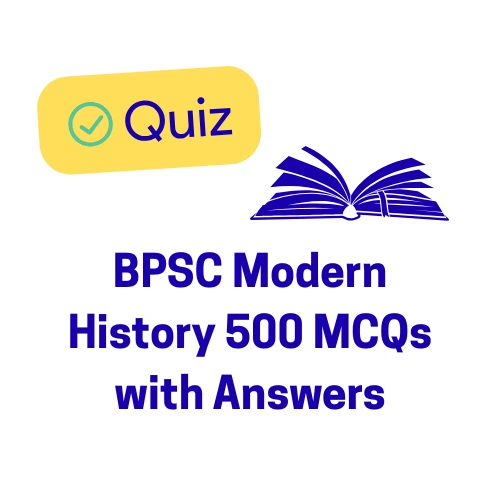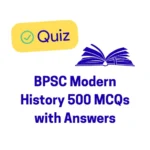BPSC Modern History Part 6 (500 MCQs) focus on the Socio-Religious Reform Movements of the 19th century, covering major organizations and reformers.
BPSC Modern History Part 6 (500 MCQs)
Section N: Socio-Religious Reform Movements (Pre-1885)
Q151. Who is widely regarded as the ‘Father of Indian Renaissance’?
(A) Swami Vivekananda
(B) Dayananda Saraswati
(C) Raja Ram Mohan Roy
(D) Ishwar Chandra Vidyasagar
Q152. Which organization was founded by Raja Ram Mohan Roy in 1828, which aimed to purify Hinduism and advocate for monotheism?
(A) Arya Samaj
(B) Tattvabodhini Sabha
(C) Brahmo Samaj
(D) Prarthana Samaj
Q153. Raja Ram Mohan Roy started the first vernacular newspaper in India in 1821, named:
(A) Mirat-ul-Akhbar (Persian)
(B) Samvad Kaumudi (Bengali)
(C) Sambad Prabhakar
(D) Bangadoot
Q154. Who split the Brahmo Samaj and later established the ‘Brahmo Samaj of India’ in 1866?
(A) Debendranath Tagore
(B) Dwarkanath Tagore
(C) Keshub Chandra Sen
(D) M. G. Ranade
Q155. The Tattvabodhini Sabha was established by which personality to promote a rational and systematic form of Upanishadic Hinduism?
(A) Ram Mohan Roy
(B) Henry Vivian Derozio
(C) Debendranath Tagore
(D) Akshay Kumar Dutt
Q156. The Young Bengal Movement was founded by which radical Anglo-Indian teacher at Hindu College, Calcutta?
(A) David Hare
(B) Alexander Duff
(C) Henry Vivian Derozio
(D) Michael Madhusudan Dutt
Q157. Who was the social reformer who successfully campaigned for the legalization of the Hindu Widows’ Remarriage Act of 1856?
(A) Ishwar Chandra Vidyasagar
(B) Jyotiba Phule
(C) Gopal Hari Deshmukh
(D) R. G. Bhandarkar
BPSC Modern History Part 6 (500 MCQs)
Q158. Pandit Ishwar Chandra Vidyasagar’s main contribution to education lay in the opening of:
(A) Universities in Calcutta, Bombay, and Madras.
(B) A large number of girls’ schools.
(C) The first modern medical college.
(D) Schools for untouchables.
Q159. The Prarthana Samaj was established in Bombay in 1867 with the aim of promoting social reform in Western India. Who were its key founders?
(A) Atmaram Pandurang and M. G. Ranade
(B) G. K. Gokhale and B. G. Tilak
(C) R. G. Bhandarkar and D. K. Karve
(D) V. S. Shastri and C. Y. Chintamani
Q160. Which social reformer from Maharashtra was popularly known as ‘Lokahitawadi’?
(A) M. G. Ranade
(B) Gopal Krishna Gokhale
(C) Gopal Hari Deshmukh
(D) Bal Gangadhar Tilak
Q161. The Arya Samaj was founded by Swami Dayananda Saraswati in 1875. Which of the following was/were the main tenet(s) of the Arya Samaj?
Rejection of idol worship and polytheism.
Acceptance of the infallibility of the Vedas.
Emphasis on the Shuddhi Movement (re-conversion to Hinduism).
(A) 1 and 2 only
(B) 2 and 3 only
(C) 1 and 3 only
(D) 1, 2, and 3
Q162. Swami Dayananda Saraswati’s famous work that summarized his views and philosophy was:
(A) Gita Rahasya
(B) Satyarth Prakash
(C) Tattvabodhini Patrika
(D) Anandamath
Q163. The slogan ‘Go back to the Vedas’ was given by:
(A) Raja Ram Mohan Roy
(B) Swami Vivekananda
(C) Swami Dayananda Saraswati
(D) Ramakrishna Paramahamsa
Section N: Socio-Religious Reform Movements (Pre-1885)
Q164. The Ramakrishna Mission was founded by Swami Vivekananda in 1897, emphasizing the philosophy of:
(A) Rationalism and Atheism
(B) Exclusive devotion (Bhakti)
(C) Service to man is service to God
(D) Violent revolution against colonial rule
Q165. Swami Vivekananda is best remembered for his speech at the Parliament of the World’s Religions held in which American city in 1893?
(A) New York
(B) Boston
(C) Chicago
(D) San Francisco
Q166. Which organization was founded by Jyotiba Phule in 1873 to work for the upliftment of the lower castes and untouchables?
(A) Paramahansa Mandali
(B) Satya Shodhak Samaj
(C) Servants of India Society
(D) Depressed Classes Mission
Q167. Who was the leader of the Ahmadiyya Movement (also known as the Qadiani Movement) in Islam, founded in 1889?
(A) Sir Syed Ahmad Khan
(B) Mirza Ghulam Ahmad
(C) Shah Walliullah
(D) Haji Shariatullah
Q168. Sir Syed Ahmad Khan is associated with the establishment of which educational institution?
(A) Darul Uloom Deoband
(B) Aligarh Muslim University (initially Muhammadan Anglo-Oriental College)
(C) Nadwatul Ulama
(D) Jamia Millia Islamia
BPSC Modern History Part 6 (500 MCQs)
Q169. The Faraizi Movement (1818), aimed at returning to the original duties of Islam, was started in Eastern Bengal by:
(A) Syed Ahmad of Rae Bareilly
(B) Haji Shariatullah
(C) Dudu Mian
(D) Shah Abdul Aziz
Q170. Which movement in Islam, starting in 1866, was founded by Muhammad Qasim Nanautavi and Rashid Ahmad Gangohi, and focused on puritanical religious instruction?
(A) Wahabi Movement
(B) Aligarh Movement
(C) Deoband Movement
(D) Ahmadiyya Movement
Q171. Who was the founder of the Theosophical Society in India (Madras) in 1882?
(A) Madame H. P. Blavatsky and Colonel H. S. Olcott
(B) Annie Besant
(C) Swami Vivekananda
(D) M. G. Ranade
Q172. The Self-Respect Movement (1925), which campaigned against Brahminical hegemony and for the dignity of the Dravidian people, was founded by:
(A) C. N. Annadurai
(B) M. G. Ramachandran
(C) E. V. Ramaswamy ‘Periyar’
(D) V. O. Chidambaram Pillai
Q173. Which organization was founded in 1887 by Behramji Malabari to promote social reform among Parsis and Hindus?
(A) Parsi Reform Association
(B) Reform Association
(C) Seva Sadan
(D) Deccan Education Society
Q174. Which major social legislation, enforced in 1891, prohibited the marriage of girls below the age of 12 years?
(A) Sarda Act
(B) Age of Consent Act
(C) Hindu Widows’ Remarriage Act
(D) Special Marriage Act
Section N: Socio-Religious Reform Movements (Pre-1885)
Q175. The Servants of India Society was founded in 1905 by which moderate leader with the aim of training national missionaries for the service of India?
(A) Bal Gangadhar Tilak
(B) G. K. Gokhale
(C) M. G. Ranade
(D) Dadabhai Naoroji
Q176. Which organization was primarily concerned with the eradication of untouchability and providing education to the depressed classes?
(A) Satya Shodhak Samaj
(B) Dharma Sabha
(C) Depressed Classes Mission Society (V. R. Shinde)
(D) Theosophical Society
Q177. Which prominent woman reformer was known for founding the Sarada Sadan (for Hindu widows)?
(A) Annie Besant
(B) Pandita Ramabai
(C) Madam Cama
(D) Sarojini Naidu
Q178. The Dharma Sabha (1830), established by Radhakant Deb, was primarily a:
(A) Reformist organization advocating the abolition of Sati.
(B) Orthodox organization that opposed the abolition of Sati and Western influence.
(C) Socio-religious body promoting English education.
(D) Political pressure group supporting the Indian National Congress.
Q179. Which leader was involved in the Deccan Education Society, which established the Fergusson College in Pune?
(A) M. G. Ranade
(B) B. G. Tilak
(C) G. K. Gokhale
(D) All of the above
Q180. The phrase ‘A Hindu and a Muslim are the two eyes of a beautiful bride’ (India) is attributed to:
(A) Sir Syed Ahmad Khan
(B) Bal Gangadhar Tilak
(C) Annie Besant
(D) Swami Vivekananda

